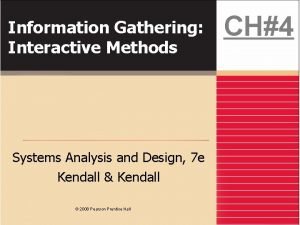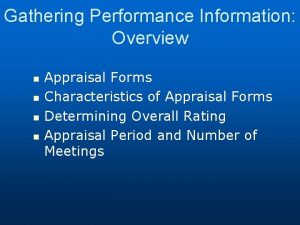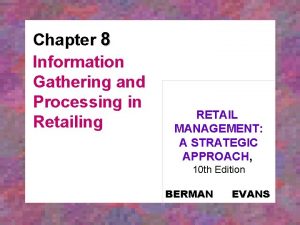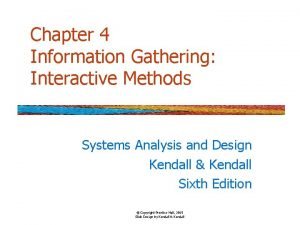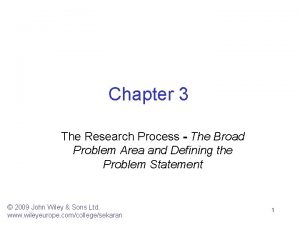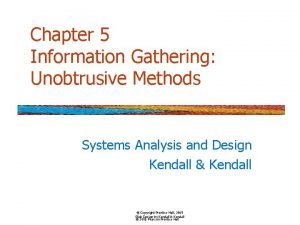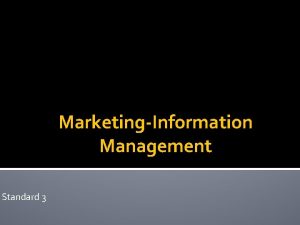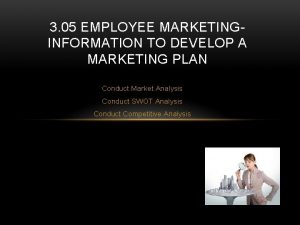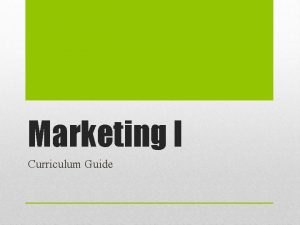Marketing Information Management STANDARD 3 MarketingInformation Management Gathering




















- Slides: 20

Marketing Information Management STANDARD 3

Marketing-Information Management Gathering, storing, and analyzing information, customers, trends, and competing products

Marketing Research The systematic gathering, recording, and analysis of data about issues relating to marketing products and services.

The Marketing Research Process Obtaining Data ◦ Primary Data – Data obtained for the first time and used specifically for the particular problem or issue under study. ◦ Secondary Data – Data already collected for some purpose other than the current study.

Methods To Collect Primary Data Surveys – information is gathered through the use of surveys or questionnaires ◦ Sample – part of the target population that is assumed to represent the entire population ◦ The bigger the sample size of people surveyed the more reliable the results. Survey Examples: internet, telephone, face-toface, focus groups, panels, etc.

Methods To Collect Primary Data Observation - Actions of people are watched either by cameras or observers Examples of Observation: Secret shoppers, store cameras, watching customers reactions to products, etc. http: //youtu. be/NG 4 l. Fm. SO 7 VQ

Methods To Collect Primary Data Experiment - Researcher observes the results of changing one or more marketing variables while keeping certain other variable constant. Experiment Examples– Taste tests, test marketing, or product sampling. Hypothesis based.

Secondary Data Sources Internal Company records – Sales charts, info on where customers live, top selling products, etc. Internet Sources – Society trends, data from a variety of research, etc. Government Reports - U. S. Census, Department of Commerce data, employment reports, etc. Professional and Trade Organizations – Wall Street Journal, National Restaurant Association, etc.

Secondary Data Advantages of Secondary Data ►Easy to obtain ►Saves time and money Disadvantages of Secondary Data ►Not suitable or available ►Sometimes inaccurate

SURVEY QUESTIONS

Constructing the Questions Questionnaires should provide data with validity and reliability. Validity exists when the questions asked measure what was intended to be measured. Reliability exists when a research technique produces nearly identical results in repeated trials.

Types of Questions Open-ended Questions ◦ Can’t be answered with Yes or No ◦ Generate a wide variety of responses ◦ Generates lots of good information but difficult to categorize and tabulate.

Types of Questions Forced-choice Questions ◦ Respondents choose answers from possibilities given on a questionnaire. ◦ Simplest questions to write ◦ Easiest to tabulate

Types of Forced Choice Questions Yes/No Questions ◦ Used only when asking for a response on one issue. ◦ Most often used as a filter question. Was our facility clean? Yes No Was your server courteous? Yes No

Types of Forced Choice Questions Multiple Choice Questions – be careful to include all possible options so you don’t frustrate the person taking the survey. What is your primary intended use of this product? (check only one) A. Backpacking/Mountaineering B. Camping/Hiking C. Hunting D. Fishing E. Other ________________

Types of Forced Choice Questions Rating Scale Questions Please rate the following: Reservations Excellent Good Average Fair Poor Check-In Excellent Good Average Fair Poor Parking Excellent Good Average Fair Poor

Types of Forced Choice Questions Level of Agreement Questions “I am extremely health conscious” SA A N D SD “I do not like vegetables. ? SA A N The cafeteria should serve heart-healthy foods. ” SA A N D SD

Guidelines Write clearly and briefly Give clear directions Avoid bias Pretest the survey Questionnaires must have excellent visual appearance and design General demographic questions go at the end Give Deadline

Market Research Assignment

M&M’s
 Information gathering interview questions
Information gathering interview questions Gathering performance information
Gathering performance information Information gathering and processing in retailing
Information gathering and processing in retailing Gathering performance information
Gathering performance information Information gathering: interactive methods
Information gathering: interactive methods Gathering information and measuring market demand
Gathering information and measuring market demand Broad problem
Broad problem Ninety types of demand measurement
Ninety types of demand measurement Gathering information and scanning the environment
Gathering information and scanning the environment Mencari peluang di lingkungan pemasaran
Mencari peluang di lingkungan pemasaran Gathering information and scanning the environment
Gathering information and scanning the environment Unobtrusive methods of information gathering
Unobtrusive methods of information gathering Gathering information and scanning the environment
Gathering information and scanning the environment The action or activity of gathering information
The action or activity of gathering information Gathering information and scanning the environment
Gathering information and scanning the environment Gathering background information
Gathering background information Gathering background information
Gathering background information What is maltego
What is maltego Finer segmentation
Finer segmentation Marketing information systems and marketing research
Marketing information systems and marketing research Marketing information systems and marketing research
Marketing information systems and marketing research
